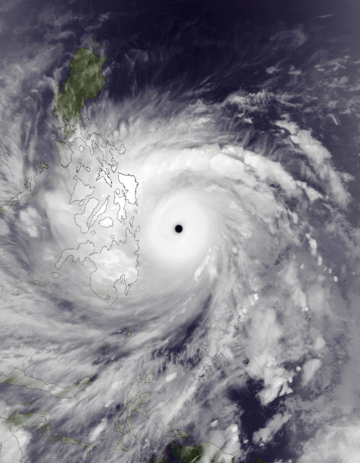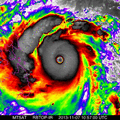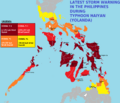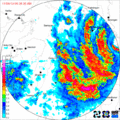Typhoon Haiyan facts for kids
| Typhoon (JMA scale) | |
|---|---|
| Category 5 super typhoon (SSHWS) | |

Typhoon Haiyan at peak intensity, on November 7
|
|
| Formed | November 3, 2013 |
| Dissipated | November 11, 2013 |
| Highest winds | 10-minute sustained: 230 km/h (145 mph) 1-minute sustained: 315 km/h (195 mph) |
| Lowest pressure | 895 hPa (mbar); 26.43 inHg (Estimated) |
| Fatalities | 6,241 confirmed, 1,785 missing |
| Damage | $1.5 billion (2013 USD) (Preliminary total) |
| Areas affected | |
| Part of the 2013 Pacific typhoon season | |
Typhoon Haiyan, also called Typhoon Yolanda in the Philippines, was one of the strongest tropical cyclones in history. It began forming on November 2, 2013, in the western Pacific Ocean. The storm grew very quickly. It became a super typhoon, which is the strongest type of tropical cyclone.
Contents
What is a Typhoon?
A typhoon is a very strong storm that forms over warm ocean waters. It is like a hurricane or a cyclone. These storms have powerful winds and heavy rain. They can cause a lot of damage when they hit land.
How Haiyan Formed
Typhoon Haiyan started as a small area of low pressure. This happened east-southeast of Pohnpei, an island in Micronesia. The warm ocean water helped it grow stronger very fast. It became a tropical storm on November 3, 2013.
Haiyan's Incredible Strength
Haiyan quickly became a super typhoon. Its winds reached speeds of about 195 miles per hour (315 km/h). This made it one of the most powerful storms ever recorded to make landfall. It was so strong that some experts called it the strongest tropical system to ever hit land.
Haiyan's Path and Impact
Typhoon Haiyan moved west across the Pacific Ocean. It gained more strength as it got closer to the Philippines. The storm hit the central Philippines with full force.
Hitting the Philippines
Haiyan made landfall in the Philippines on November 8, 2013. It brought extremely high winds and a massive storm surge. A storm surge is like a giant wall of water pushed onto land by the storm. This surge caused a lot of flooding.
Damage and Effects
The storm caused huge damage, especially in the Visayas region of the Philippines. Many homes and buildings were destroyed. Roads and power lines were also badly damaged. This made it hard for people to get help.
Sadly, thousands of people lost their lives. Many more were injured or went missing. The storm also affected millions of people who lost their homes or livelihoods. The total damage was estimated to be very high.
After the Storm
After Haiyan passed, many countries and organizations sent help. They provided food, water, medicine, and shelter. Rescue teams worked hard to find survivors. People worked together to start rebuilding their communities.
Recovery Efforts
The recovery from Typhoon Haiyan was a long process. It took a lot of effort to clear debris and rebuild homes. Many people helped to bring life back to normal in the affected areas. This included local volunteers and international aid workers.
Images for kids
See also
 In Spanish: Tifón Haiyan para niños
In Spanish: Tifón Haiyan para niños















